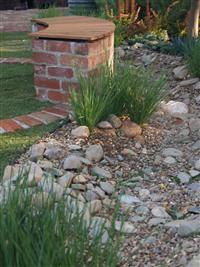Coloured Pebbles In The Garden
Coloured gravels were used in 18th century France to create designs on the surface of the ground – in effect partitioning the ground, often into geometric/symmetrical patterns.
Red or brown gravel might have been used to mark out circles, rectangles or squares enclosed by low hedges, with white or cream gravel to create paths outside of the hedging. In this way, very simple gardens created a high impact – with patches of contrasting colour covering the ground, separated by low green hedging.
The same idea can be used today to create a distinctive garden feature. Pebbles are currently very trendy, with landscape designers using them as mulches, in mosaics and paving, and to surface paths and driveways. There are even pebble specialists that supply a large range of local and imported stones, in a range of different textures and colours.
What’s the difference between gravel and pebbles?
Gravel is made from crushed rock. The stones have an angular, irregular shaped surface.Pebbles are smooth stones that have been naturally shaped by water, coming either from riverbeds or the seashore. Some pebbles are polished and tumbled before sale
 Maintaining Pebbled and Gravelled Areas
Maintaining Pebbled and Gravelled Areas
Weeds can be a problem when using pebbles. The most effective treatment is to eradicate weeds with a glyphosate herbicide before laying the pebbles.A weed mat can be of some use, but only on flat, bare ground. On sloping ground, the pebbles will wash down the slope, leaving an expanse of ugly matting.
A thick layer of pebbles will effectively choke out weeds. Any weeds that do appear will be fairly easy to pull out of the gravel but take care not to spread soil from the roots over the gravel surface, as this can encourage weed seeds to take root.Hand weed or spot spray any weeds as soon as they grow through the gravel – never let them set seed, otherwise you will end up with a major weed problem.Also take care to prevent weeds blowing seeds across from nearby garden beds.
How thick should gravel or pebbles be?
The thickness of pebbles and gravels depends on their use:
- A gravel mulch will need to be around 40-60 mm deep.
- A mulch around pots around 10-20 mm deep.
- Gravel paths should be around 30-70 mm deep.You will have to top up gravel paths every now and then as chippings get removed through wear and tear, i.e. people’s shoes, rain, hosing and so on.
The ancient English put lime on the soil to stop the growth of weeds, while the ancient Romans put salt down.
These treatments are still used to control weeds thousands of years later …so if you do something like this effectively, it can be very permanent! (But don’t use it in areas where you want to grow ornamental plants.)
Other places to use pebbles
- Set in concrete (for cobble paving or mosaic walling)
- Between pavers, for contrasting texture and colour
- Inlaid in garden furniture, e.g. table tops
- As a pebble beach at the edge of a pool or water garden
- At the base of a pond, to hide the liner and provide anchorage for water plants
- On the surface of tub plants, for decoration and as a mulch
- As a mulch around plants to reduce weeds and for visual effect
- In a succulent garden, to provide a well-drained growing media and as a colour contrast with the plants
- In an artificial dry creek bed
- At the base of a waterfall to create a splashing noise
- In Oriental gardens, raked in patterns
Want to Know More?
Consider doing a course or buying a reference book from our school.
If you would like to communicate with one of our professional tutors, consider using our free course counselling service. click for details
If you want to browse our bookshop, go to www.acsbookshop.com
To browse our courses, go to http://www.acsgarden.com/Courses/Default.aspx
More from ACS
Ebook - Inspiring: covers formal, natural, eclectic, modern, oriental, Mediterranean; zoom in on stunning images and plans.
View eBook
Ebook - Explores garden design ideas and inspires
garden design and landscaping!
View eBook
Ebook - Identify, select, grow, care, propagate, landscape,
dictionary of perennials.
View eBook
Course - draw designs, survey sites, understand plants, soils, timbers, climate, and other landscape materials pivotal to the success of a good landscape design.
View Course
Course - Popular design certificate that has launched many enthusiastic and talented design students into the industry.
View Course